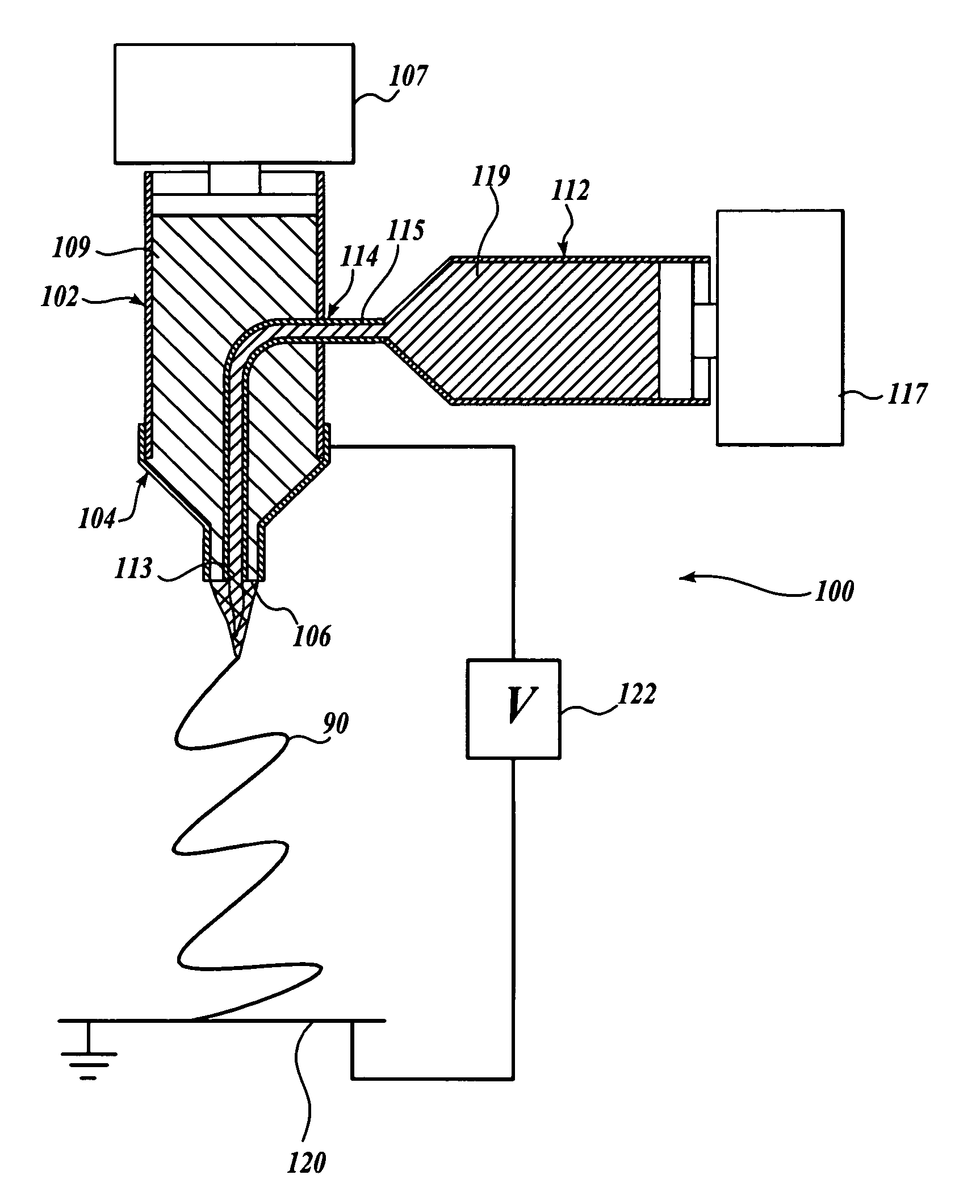Electrospinning of fine hollow fibers
a hollow fiber and electropinning technology, applied in the field of electropinning nanofibers, can solve the problems of difficult to create hollow nanofibers of long length using prior art methods, significant and well-known limitations of this approach,
- Summary
- Abstract
- Description
- Claims
- Application Information
AI Technical Summary
Benefits of technology
Problems solved by technology
Method used
Image
Examples
example 1
[0022]In this example of the present invention, hollow fibers of ceramic / polymer composite—in the illustrative example, a TiO2 / poly(vinyl pyrrolidone) (PVP) composite or pure ceramic nanofibers—were produced utilizing the apparatus 100 shown diagramatically in the figure. In particular, a spinneret having two coaxial apertures was fabricated by inserting a polymer-coated silica capillary 114 with an inner diameter of 75 or 100 microns and an outer diameter of 200 microns into a stainless steel needle 104 having an inner bore diameter of 450 microns, such that the distal end 113 of the capillary 114 is substantially concentric with the bore of the stainless steel needle 104. The needle 104 was hosted on a first plastic syringe 102 and the silica capillary 114 penetrated the wall of the first plastic syringe 102 and connected to a second plastic syringe 112. (The joints were sealed with an epoxy.) A polymeric solution 109 was provided in the first syringe 102, the solution consisting ...
example 2
[0031]By modifying the mineral oil core fluid 119 with various precursors, hollow nanofibers containing different functional components may be fabricated. For example, hollow nanofibers of titania containing iron oxide nanoparticles were obtained by feeding a dilute, oil-based ferrofluid to the core capillary 114, followed by alkane (e.g. octane) extraction of the oil phase. The resultant nanofibers were magnetically active. Alternatively, by adding tin isopropoxide to the oil core fluid, hollow titania nanofibers with tin oxide nanoparticles coating their inner surfaces have also been fabricated.
[0032]In order to extend the utility of composite and ceramic hollow nanofibers in applications, such as catalyst supports, optical waveguides, and nanofluidic devices, selective modification and differentiation of the inner and / or outer surfaces are highly desirable. Derivatizing the surfaces of these hollow nanofibers with different functional groups changes the surface chemistry, thereby...
example 3
[0042]In another application of the present invention, the two-capillary, core-sheath, electrospinning process provided a novel method for producing electrospinning fibers of conjugated polymers. Conjugated polymers are important for their unique combination of electronic, optical, and mechanical properties. Nanowires or nanofibers made of conjugated polymers present an ideal system for studying charge transport and luminescence in one-dimensional systems and hold promise as the building blocks for nanoelectronics. However, conventional electrospinning requires the use of an appropriate solvent and polymer system to prepare solutions exhibiting the desired viscoelastic behavior. In particular, the traditional setup for electrospinning is not easily applied to polymers with limited solubilities (e.g., conjugated polymers) or low molecular weights. One prior art strategy for improving the spinnability of conjugated polymers is to blend these polymers with other spinnable polymers in s...
PUM
| Property | Measurement | Unit |
|---|---|---|
| temperature | aaaaa | aaaaa |
| diameter | aaaaa | aaaaa |
| diameter | aaaaa | aaaaa |
Abstract
Description
Claims
Application Information
 Login to View More
Login to View More - R&D
- Intellectual Property
- Life Sciences
- Materials
- Tech Scout
- Unparalleled Data Quality
- Higher Quality Content
- 60% Fewer Hallucinations
Browse by: Latest US Patents, China's latest patents, Technical Efficacy Thesaurus, Application Domain, Technology Topic, Popular Technical Reports.
© 2025 PatSnap. All rights reserved.Legal|Privacy policy|Modern Slavery Act Transparency Statement|Sitemap|About US| Contact US: help@patsnap.com


